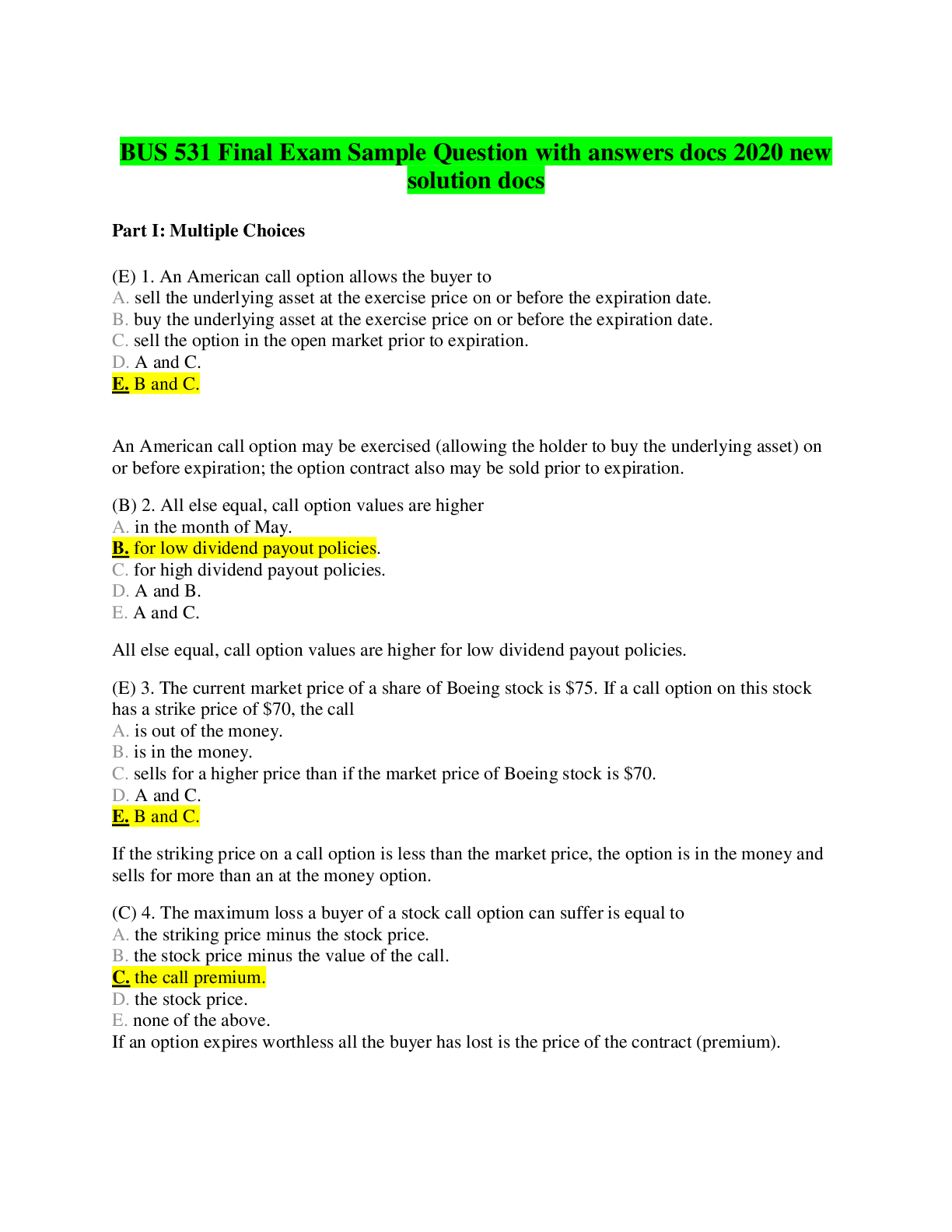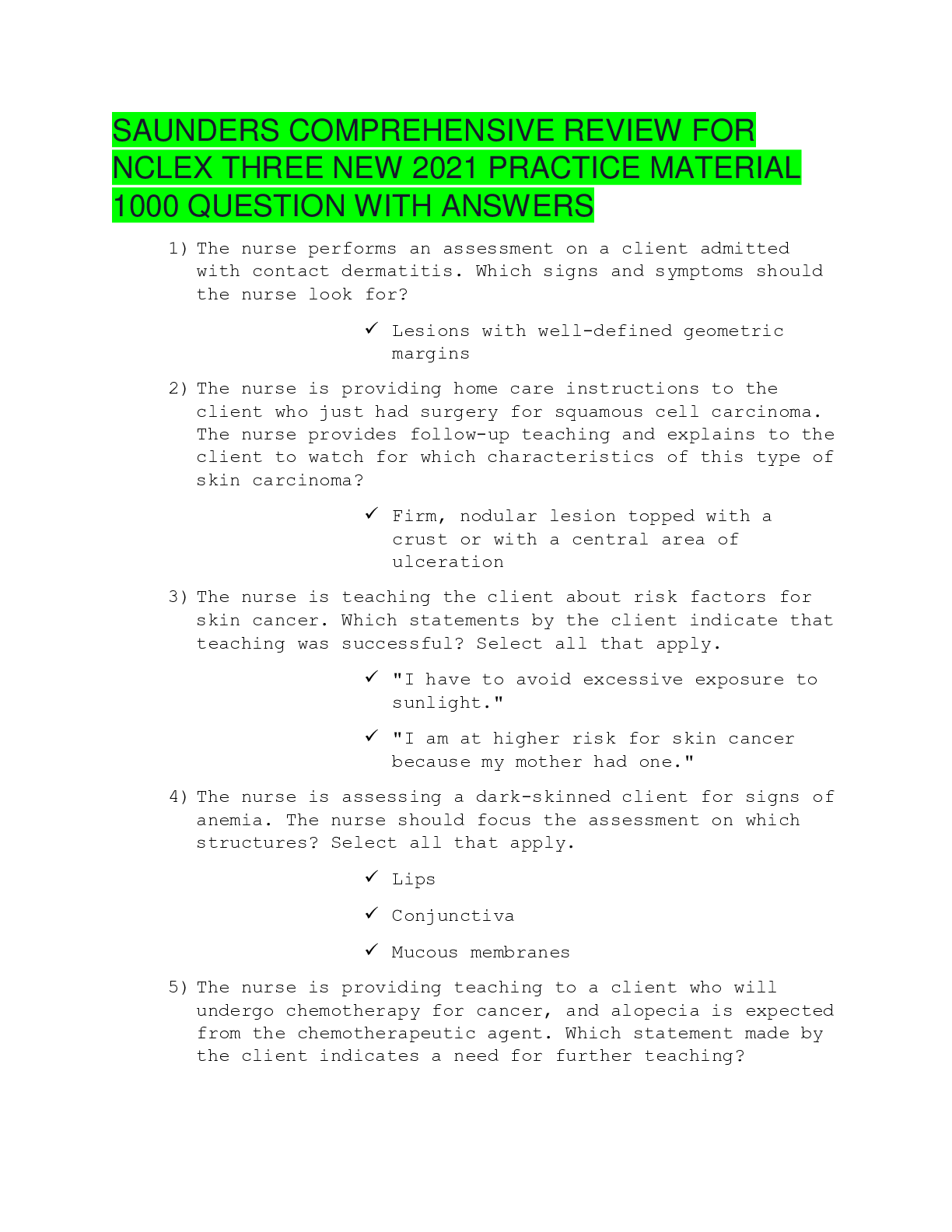Statistics > QUESTIONS & ANSWERS > STA 2023 Final Exam, Top Question with accurate answers, 100% Accurate, rated A+ (All)
STA 2023 Final Exam, Top Question with accurate answers, 100% Accurate, rated A+
Document Content and Description Below
STA 2023 Final Exam, Top Question with accurate answers, 100% Accurate, rated A+ Population - ✔✔-A collection or set of individuals, objects or events whose properties are to be analyzed. ... Data is rarely collected from the entire population - instead a representative sample is used Sample - ✔✔-a subset of the population Parameter - ✔✔-a numerical value summarizing all data of the population statistic - ✔✔-a numerical value summarizing all data of the sample Statistic or Parameter? A health club surveys 40 randomly selected members and found the avg weight is 157 lbs - ✔✔-statistic Statistic or parameter? A researcher examines records of all registered voters and finds 43% are registered democrats - ✔✔-parameter variable - ✔✔-characteristic of the individuals within the population or sample qualitative - ✔✔-non-numerical characteristic may or may not be numbers, but the numbers have no real meaning (e.g., SSN, eye color) You cannot do any math with qualitative data (i.e., adding or subtracting SSNs doesn't give you anything meaningful) quantitative - ✔✔-numerical measurements in which the numbers have meaning. You can compare the numbers and the comparison will make sense Ex: fat content of different cookies discrete data - ✔✔-whole numbers countable continuous data - ✔✔-non-count What are the 4 levels of measurement? - ✔✔-1) Nominal 2) Ordinal 3) Interval 4) Ratio nominal data - ✔✔-qualitative data ONLY Cannot be ordered, cannot be used for calculations Ex: eye color, SSN Ordinal data - ✔✔-can be qualitative or quantitative Data can be ordered, but there is no meaning placed on the order Ex: if you are 5th in line, this doesn't mean you are 5 times better than the 1st person in line. Interval data - ✔✔-Quantitative data You can calculate differences between the data Zero is NOT the starting point of the data, but it does contain zero, but it is NOT a true zero (e.g., 0 degrees F does not mean there is no heat at all) Begin to see meaning in data b/c you are able to subract Ex: IQ - there is a meaningful difference between an IQ of 109 and 110. Ex 2: temperature Ratio - ✔✔-Interval data PLUS you can form ratios, so you can express one point as a multiple of another, i.e., you can DIVIDE the data Ratio data starts at zero - there are NO negatives. Ex: fat contents of cookies. You can divide to show that cookie B has twice the fat of cookie A Quant or Qual? Nominal, Ordinal, interval or ratio? Temperatures of ocean at various depths - ✔✔- quantitative, interval Quant or Qual? Nominal, Ordinal, interval or ratio? The subjects in which college students major - ✔✔- Qualitative, nominal Quant or Qual? Nominal, Ordinal, interval or ratio? Salaries of college Profs - ✔✔-Quantitative, ratio Quant or Qual? Nominal, Ordinal, interval or ratio? Survey responses of "good, better, best" - ✔✔- Qualitative, ordinal (sequential order) random sample - ✔✔-n measurements selected so that every member from the population has an equal probability of being selected simple random sample - ✔✔-n subjects selected in a way that every possible sample of the sample size has the same chance of being chosen. stratified sampling - ✔✔-groups or classes within population share common a common characteristic called "strata". Ex: in undergrad population, you may divide into freshmen, sophomores, etc. THEN SRS is drawn from each stratum systematic sampling - ✔✔-All elements of population arranged in some natural sequential order Then random starting point selected and every kth element selected for the sample cluster sampling - ✔✔-divide demographic area into sections then randomly select some sections or clusters every member of the cluster is included in the sample frequency distribution - ✔✔-a table that displays data broken into natural groups, called classes frequency - ✔✔-f - the number of times a value appears in data relative frequency - ✔✔-f/n cumulative frequency - ✔✔-the sum of frequencies for that class and all previous classes Can be given as a decimal, fraction, or percent Cumulative freqs of all classes should add up to 1 class width - ✔✔-(max-min)/# of classes **Always round UP** lower class limits - ✔✔-use min for first lower class limit Then add class width to first lower class limit to get next lower class limit class boundaries - ✔✔-(first upper class limit + next lower class limit) / 2 then subract answer from every lower class limit Add answer to every upper class limit class midpoint - ✔✔-(lower class limit + upper class limit) / 2 histograpm - ✔✔-y axis = frequency x axis = class boundaries NO gaps between bars - bars connected frequency polygon - ✔✔-displays frequency and class midpoints midpoints are connected by line segments Ex: see ch. 2 notes p. 3 ogive - ✔✔-line graph that shows cumulative frequency stem and leaf plot - ✔✔-shows raw data normal distribution - ✔✔-bell-shaped curve mean=median=mode frequency distribution is symmetric uniform - ✔✔-all entries (classes) have the same frequency, so there's a straight line across the graph skewed - ✔✔-there is an elongated tail on one side left (negatively) skewed - ✔✔-long tail is to left right (positively) skewed - ✔✔-long tail is to right What are the measures of Central Tendency? Aka measures of center - ✔✔-1) mean 2) median 3) mode mean - ✔✔-average (sample mean (x-bar) or population mean (mu) NOT resistant to outliers median - ✔✔-physical middle of the data resistant to outliers to find, put data in order then, calculate (n+1) / 2 to find the POSITION of the median Then locate that position **if you have an even number of values, take the average of the 2 middle values** mode - ✔✔-the number that shows up most frequently weighted mean - ✔✔-x-bar=∑(x×w) / ∑w w is the "weight" sample variance or sample standard deviation for grouped data - ✔✔-grouped data = frequency table format use class midpoint for x empirical rule - ✔✔-used with frequency distributions that have a symmetric bell shape 1) 68% of data will lie within 1 stand dev of mean (x-bar - s) 2) 95% of data will lie within 2 stand devs of mean (x-bar - 2s) 3) 99.7% of data will be within 3 stand devs of mean (x-bar - 3s) fractiles - ✔✔-numbers that partition/divide an ordered data set itno equal parts Ex: median is fractile b/c it divides ordered data set into two equal parts percentile - ✔✔-the pth percetile is a value representing that AT LEAST p% of data is at or BELOW it divides data set into 100 equal parts How to find percentile? - ✔✔-list your data in INCREASING order then use a location formula: L = n × p/100 **if L is a whole number, average it with next higher one** ***If L is NOT whole, round UP for location of percentile*** Then find location 3 quartiles divide ordered data set into 3 equal parts - ✔✔-Q₁= P25 Q₂= P50 Q₃= P75 Inner Quartile Range - ✔✔-= IQR The difference between Q3 and Q1 (IQR = Q3-Q1) **Any data value that is more than 1.5 IQRs to left or Q1 or 1.5 IQRs right of Q3 is an outlier** How to create a boxplot? - ✔✔-1. put data in order 2. Get 5-number summary: min, Q1, Q2, Q3, max 3. make a box with Q1, Q2, Q3 4. mark min and max with dots and connect to box Modified boxplot - ✔✔-for a modified boxplot, include outliers as points, but do not connect to line or box range rule of thumb - ✔✔-the majority of sample values (≈95% for instance) lie within 2 standard devs of the mean **so, if something doesn't fall within two standard devs of the mean, it is UNUSUAL** what does standard deviation measure? - ✔✔-the average variation of all values from the mean it is usually positive only 0 when all numbers are the same never negative outliers can dramatically affect it how would you *estimate* standard deviation (ch. 3) - ✔✔-s ≈ range / 4 (ch. 3 p. 104) z-score - ✔✔-aka standardized value = number of standard deviations a given value x is above or below the mean **when a data value is less than the mean, its z-score is negative** Sample z-score: z= (x - x-bar) / s Population z-score z= (x - Mu) / sigma round to 2 decimal places unusual values (z-scores) - ✔✔-unusual values have z scores less than -2 or greater than 2 Ordinary: -2 ≤ z-score ≤ 2 Unusual: z-score < -2 or z-score > [Show More]
Last updated: 2 years ago
Preview 1 out of 18 pages

Buy this document to get the full access instantly
Instant Download Access after purchase
Buy NowInstant download
We Accept:

Reviews( 0 )
$9.00
Can't find what you want? Try our AI powered Search
Document information
Connected school, study & course
About the document
Uploaded On
Mar 16, 2023
Number of pages
18
Written in
Additional information
This document has been written for:
Uploaded
Mar 16, 2023
Downloads
0
Views
103

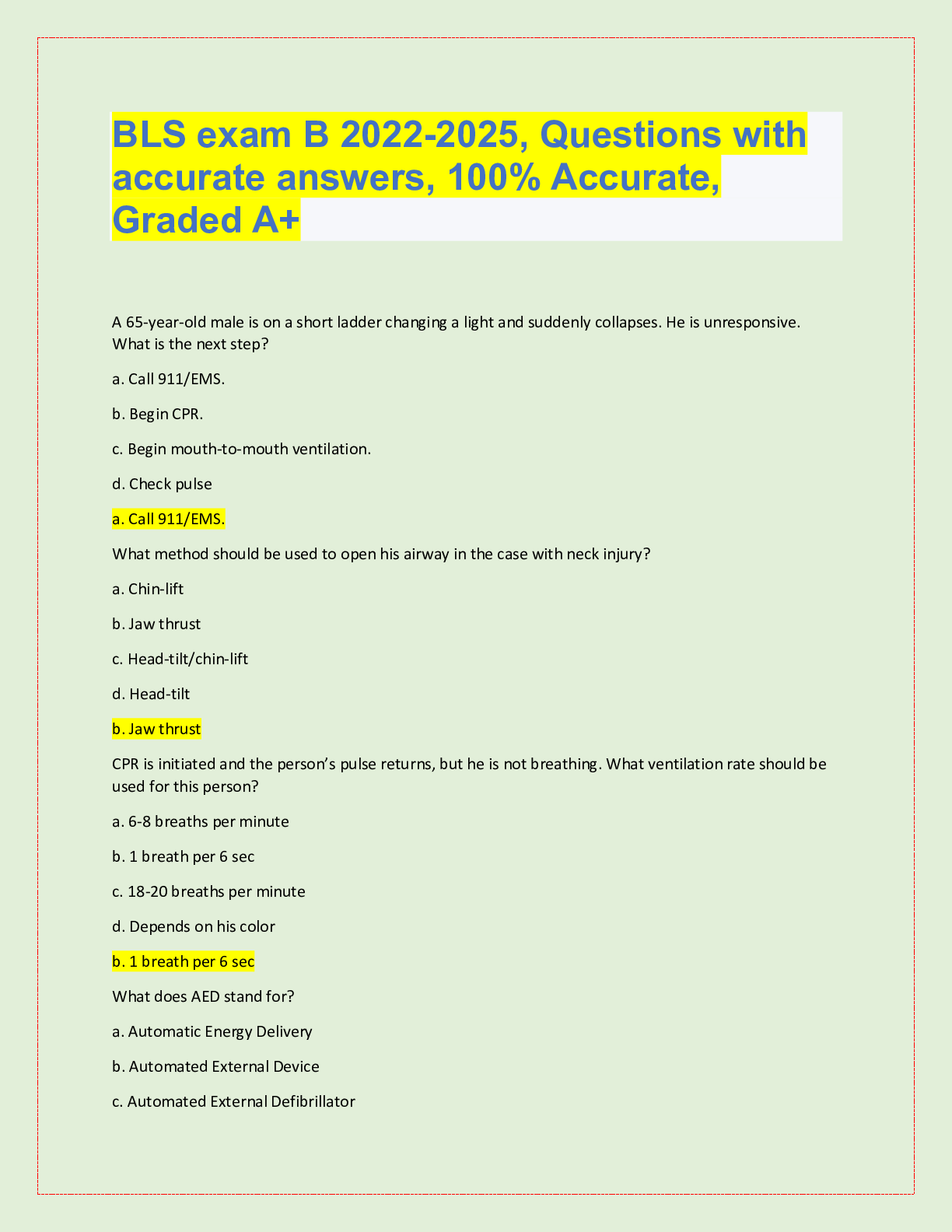











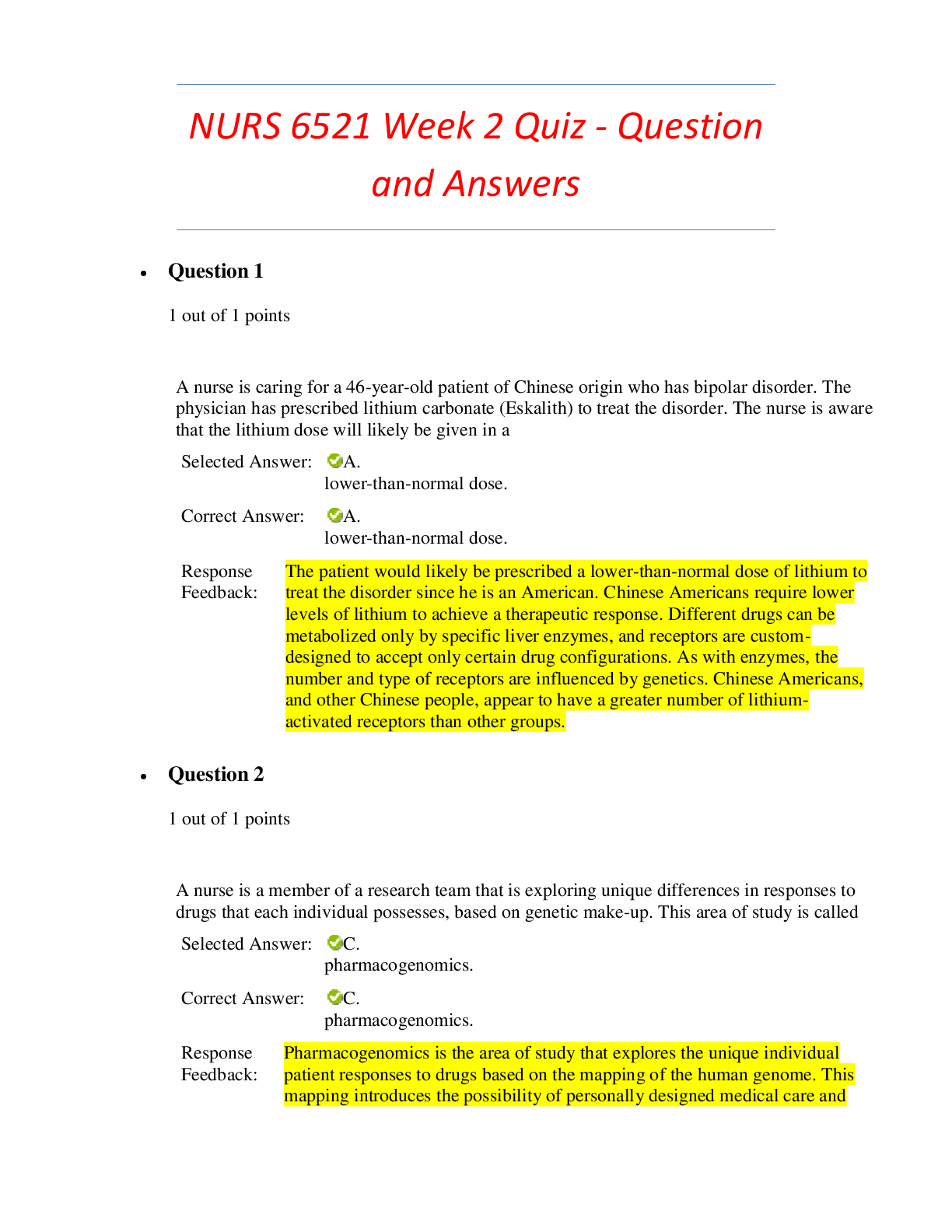

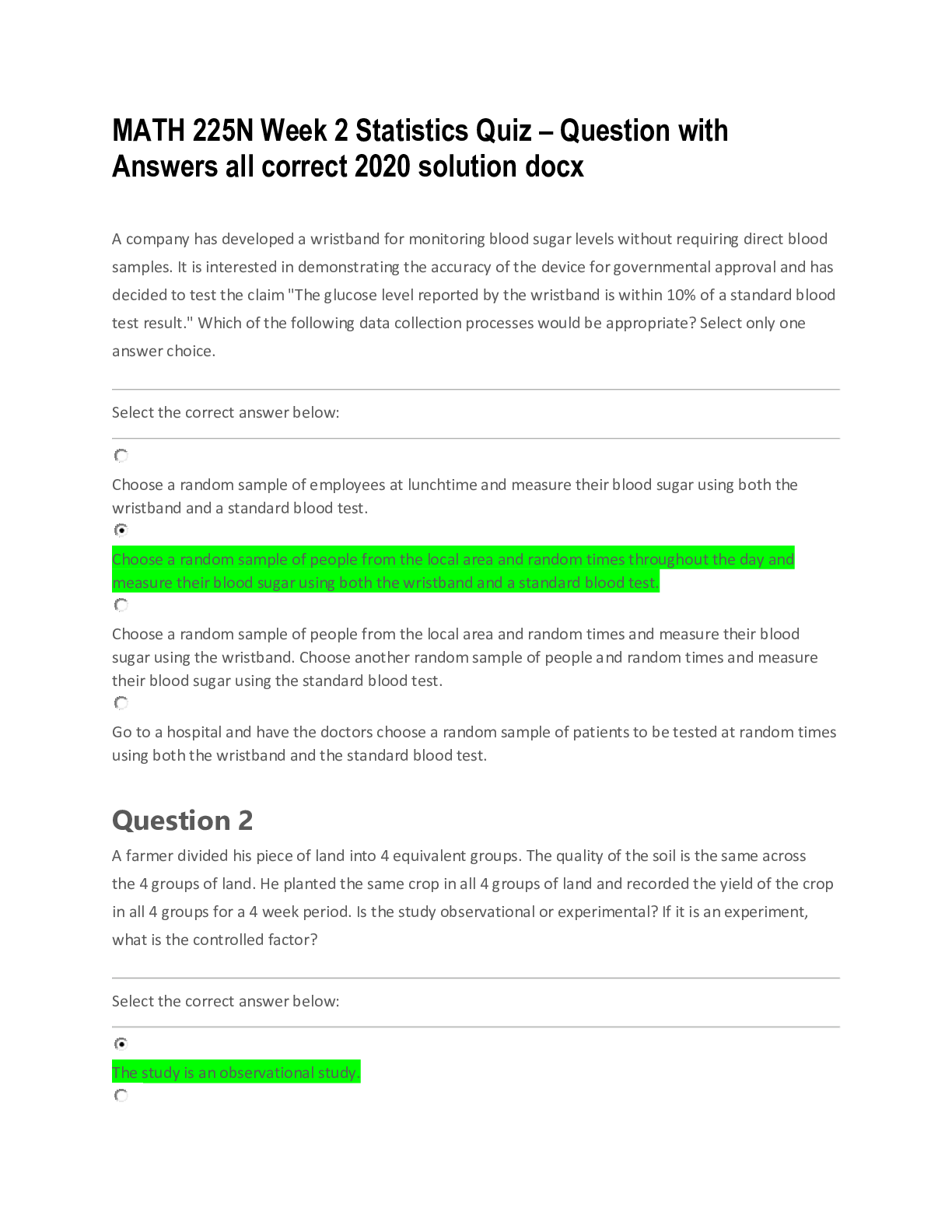
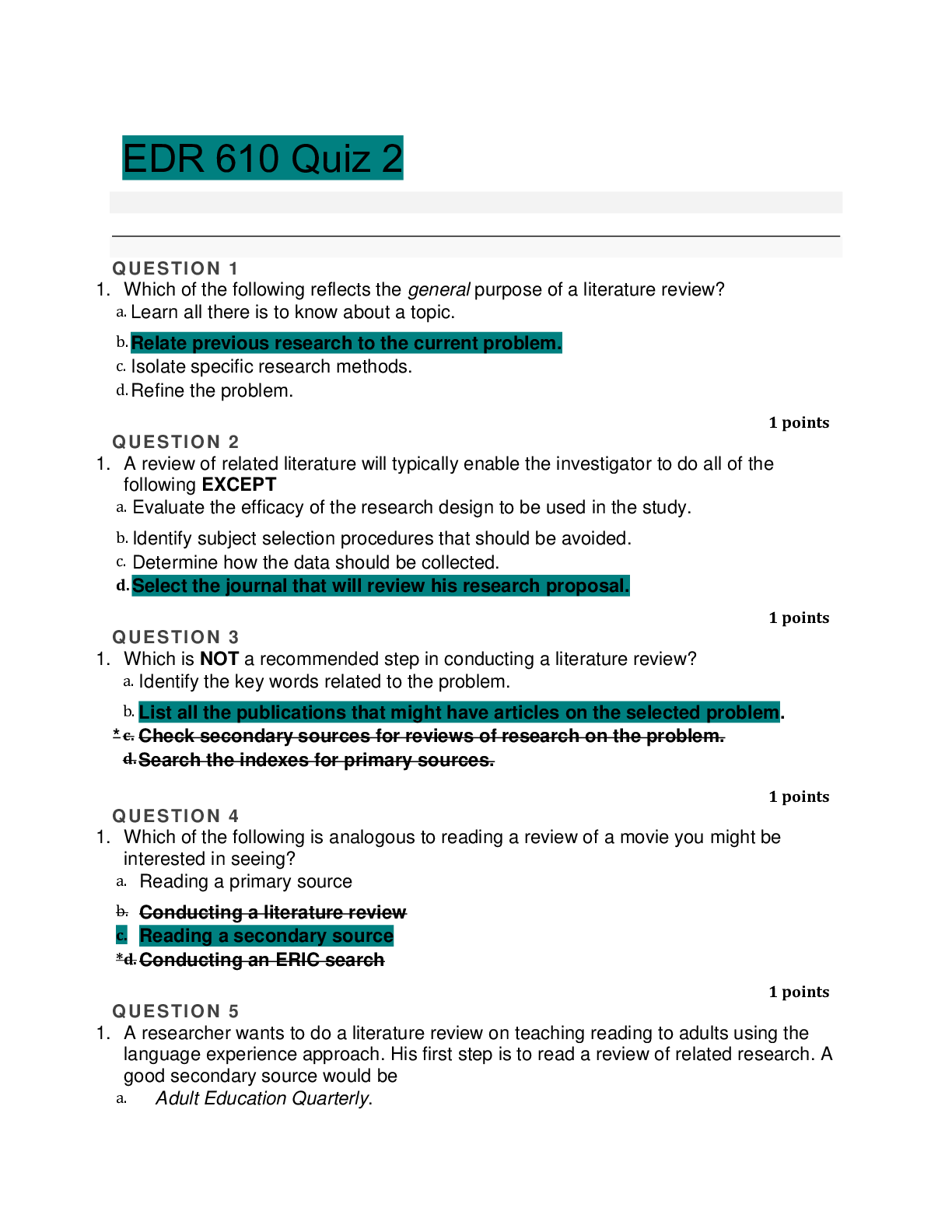
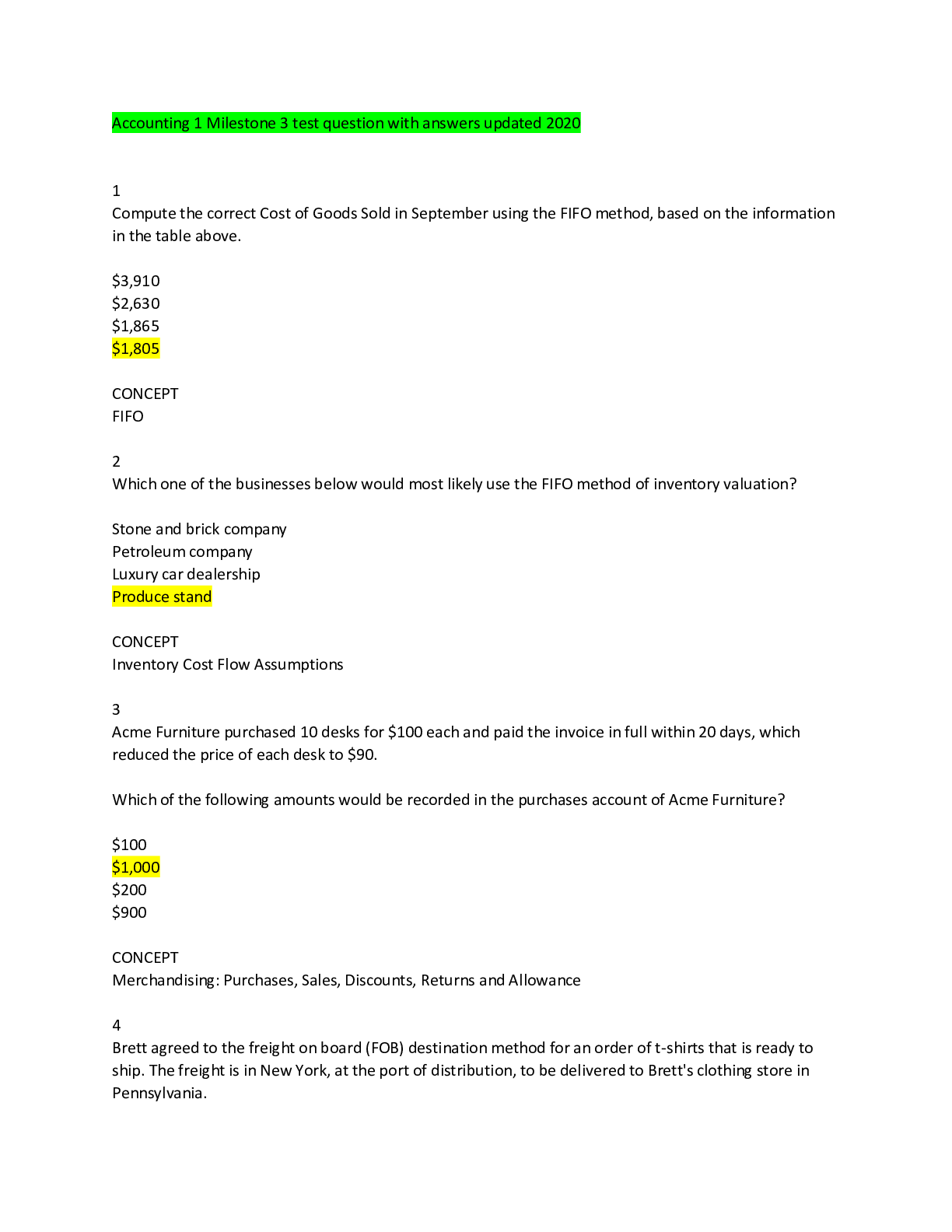
 ans.png)

